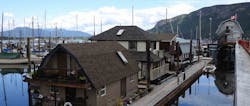Recently my wife and I went to the beautiful city of Victoria located on Vancouver Island in British Columbia, Canada, for a vacation. At the time, the furthest thing from my mind was HVDC technology or anything remotely associated with power electronics, but you never know what you’ll run into. We took several trips outside of the city and it was one of these excursions that caused my brain to switch from tourist mode to engineer. The picturesque little harbor town of Cowichan Bay is located on the eastern side of Vancouver Island on the Georgia Straight. This is the same Georgia Straight that is home to a series of submarine cables (AC and DC) to make an interconnection with the Canadian mainland. A little north of Cowichan Bay is the municipality of North Cowichan, which is the terminus of the Vancouver Island HVDC Interconnection.
The reason that obscure fact stuck in my mind is that the Vancouver Island Interconnection holds a historical place in HVDC technology. It was a hybrid converter station using both mercury-arc valve and thyristor valve technologies at the same time. It was also the last HVDC scheme in North America to have operating mercury-arc valves. The Interconnection stayed operational well into the 21st century, but the mercury-arc valves have been out of service for several years now. When I say the last mercury-arc valve in North America, it’s because this scheme wasn’t the world’s last operational mercury-arc valve system. That honor goes to the Inter-Island link between the North and South Islands of New Zealand. Inter-Island stayed in service a few years longer than Vancouver and was decommissioned in 2012.
Getting back to the Vancouver Island Interconnection; it was commissioned in 1968 as a 312-MW HVDC mercury-arc system built by ASEA. The system linked the island to the Canadian mainland using a combination of overhead line sections and submarine cables for the HVDC transmission system. In 1977 a second 370-MW HVDC pole was added to the scheme using thyristor valve technology built by GE. It used a metallic return when the current was lower than 600 amperes and an earth return when the current was higher. As the Interconnection’s converter technology became obsolete, an HVAC system was installed between the island and the mainland. The HVAC transmission also uses submarine cables to cross the strait and overhead transmission lines for the land portion. Pole #1 (mercury-arc) was decommissioned, but pole #2 (thyristor valves) has been kept as an operational backup scheme to the HVAC system if needed.
The decommissioning of mercury-arc valves at New Zealand’s Inter-Island link and Vancouver Island’s Interconnection marked the end of mercury-arc technology, which had lasted more than half a century. Early in my career, I was able to visit Manitoba Hydro’s Dorsey Converter Station, which had the largest and most powerful mercury-arc valves ever developed for a converter station. These mercury-arc valves were built by English Electric. I can still picture the huge valve hall and the size of the valves with their pools of mercury. The thing I remember most vividly was the vast amount of space needed for the converter and the large numbers of engineers and technicians required to keep these marvels operating.Technology moved forward and the thyristor was introduced in the 1970s, which eliminated the limitations associated with the mercury-arc valves.
Once the thyristor began deployment, mercury-arc valve manufacturing was stopped. Over time the existing mercury-arc schemes were replaced by thyristors or retired. Now these devices can only be found in museums or on display at a few converter stations. I have seen one of Gotland’s mercury-arc valves and one of Pacific Intertie’s valves on display in the lobby area of BPA’s Celilo Converter Station in The Dallas, Oregon. Several other utilities have saved a valve or two, but viewing is limited. Hopefully they will be made available in venues more accessible for public viewing. If you get a chance to see these devices, it is really worth the effort.
About the Author
Gene Wolf
Technical Editor
Gene Wolf has been designing and building substations and other high technology facilities for over 32 years. He received his BSEE from Wichita State University. He received his MSEE from New Mexico State University. He is a registered professional engineer in the states of California and New Mexico. He started his career as a substation engineer for Kansas Gas and Electric, retired as the Principal Engineer of Stations for Public Service Company of New Mexico recently, and founded Lone Wolf Engineering, LLC an engineering consulting company.
Gene is widely recognized as a technical leader in the electric power industry. Gene is a fellow of the IEEE. He is the former Chairman of the IEEE PES T&D Committee. He has held the position of the Chairman of the HVDC & FACTS Subcommittee and membership in many T&D working groups. Gene is also active in renewable energy. He sponsored the formation of the “Integration of Renewable Energy into the Transmission & Distribution Grids” subcommittee and the “Intelligent Grid Transmission and Distribution” subcommittee within the Transmission and Distribution committee.
